Morocco emerges as Africa’s first host of a battery gigafactory in $5.6 billion China-backed deal

A $5.6 billion investment led by Chinese company Gotion High-Tech will establish Africa's first battery gigafactory in Kenitra, northwestern Morocco.
This facility will produce essential components for electric vehicle batteries, including cathodes and anodes. It aims to supply European automakers, Morocco’s local automotive sector, and the renewable energy storage markets across Africa and the Middle East.
The project is designed to significantly boost employment, with the initial development phase expected to generate 2,300 jobs. Across its full five-phase plan, the gigafactory is projected to create up to 10,000 jobs. The first phase alone is expected to result in 17,000 direct and indirect job opportunities.
Production is scheduled to begin in late 2026 with an initial capacity of 20 gigawatt-hours (GWh), which is expected to scale up to 100 GWh.
What this means
Unlike many other plants that rely on imported materials, this facility will manufacture the core materials required for battery production. By producing electrode materials such as cathodes and anodes on-site, the factory offers Morocco enhanced supply chain security and cost competitiveness. This vertical integration reduces reliance on foreign imports and strengthens Morocco’s autonomy in the high-tech manufacturing space.
Around 85% of the batteries produced at the site will be exported to the European Union. This helps reduce Europe’s dependence on Asian markets and shortens supply chains for the automotive sector. Morocco is shifting from being an assembly point to a key manufacturing hub serving one of the largest consumer markets globally.
The gigafactory’s development will follow a modular roadmap. It will commence with a first stage in 2026 and expand progressively as contracts and funding are secured. This approach is designed to allow flexibility and scalability in response to evolving energy market dynamics.
Local production of essential battery components will help Morocco reduce its import dependency. The project's vertical integration is expected to stabilise regional supply chains and strengthen Morocco's competitive position amid growing global demand for battery technology.
This initiative also marks a strategic shift for Africa. By building manufacturing capabilities on the continent, the project offers a model for transitioning from raw material exportation to high-value industrial production. It allows African countries to gain more economic value from their natural resources.
China-Morocco partnership
China remains Morocco’s third-largest global trading partner and its largest in Asia. In 2024, bilateral trade amounted to $9.04 billion, with China exporting $7.74 billion and importing $1.3 billion from Morocco, China’s Foreign Affairs Ministry reported.
The partnership reflects China's expanding economic involvement in Africa. It aligns with China’s strategy of combining infrastructure investment with industrial development in the clean energy sector.
For Morocco, the gigafactory represents a step forward into high-tech manufacturing, economic diversification, and a strengthened role as a strategic link between Africa, Asia, and Europe in the global green economy.
China's broader investment strategy in Africa
In May, China pledged to increase its investment across Africa.
Shen Xiang, Director of the West Asia and Africa Department at China’s Ministry of Commerce, stated, “African countries have seen steady economic development in recent years, with the overall business environment continuing to improve and the willingness of Chinese firms to invest in the continent significantly growing.”
According to Shen, annual direct investment from Chinese firms in Africa has exceeded $3 billion over the past five years, covering a variety of sectors.
This story is written and edited by the Global South World team, you can contact us here.